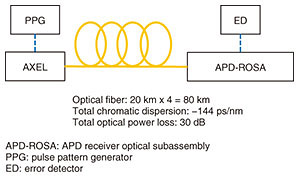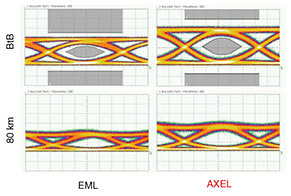 |
|||||||||||||||||||||||||||||||||||
|
|
|||||||||||||||||||||||||||||||||||
|
Regular Articles Vol. 17, No. 10, pp. 42–49, Oct. 2019. https://doi.org/10.53829/ntr201910ra1 High Power and High Efficiency Operation of Semiconductor Optical Amplifier Assisted Extended Reach Electroabsorption Modulated DFB Laser (AXEL) for Extension of Transmission DistanceAbstractWe have designed a semiconductor optical amplifier integrated with an electroabsorption modulator integrated distributed feedback laser (EML). We call this device AXEL; it is designed to enhance the power conversion efficiency and modulated light output power of EMLs. In this study, we investigated AXELs for both the L-band and O-band wavelength ranges. The results of experiments indicated that dramatically increased power conversion efficiency and modulated light output power were obtained with the fabricated AXELs. For the L-band wavelength range AXEL, a high modulated light output power of 9 dBm and an extension of 10-Gbit/s transmission distance to 80 km due to low chirp characteristics of the AXEL were simultaneously demonstrated. In addition, the 25-Gbit/s 80-km transmission achieved using the O-band wavelength range AXEL along with an avalanche photodiode was demonstrated for the first time thanks to the significantly increased modulated light output power of the AXEL. Keywords: electroabsorption modulator, distributed feedback laser, semiconductor optical amplifier 1. IntroductionElectroabsorption modulator integrated distributed feedback (DFB) lasers (EMLs) are employed in many applications that use intensity-modulation direct-detection (IM-DD) schemes because of their high extinction ratio and low chirp characteristics compared with directly modulated lasers (DMLs) [1–3]. To meet the demand for huge data capacity, which is increasing exponentially due to the growing use of various services and devices, future optical communication systems will require a light source that can operate at high speed with high output power, and they will need to transmit over long distances. Therefore, it is very important to enhance the power conversion efficiency of the EML without degrading the transmission characteristics. However, there is a limitation on how much the modulated light output of the EML can be enhanced without significantly increasing the power consumption. This is because the electroabsorption modulator (EAM) has a large modulation loss, generally around 5 dB. The optical power loss in the EAM becomes large as the input power of the DFB laser diode (LD) becomes large in efforts to enhance the modulated light output. Therefore, it is intrinsically difficult to enhance the modulated light output of an EML without significantly increasing the power consumption. In other words, the intrinsic power conversion efficiency of the EML is very small compared with that of DMLs. To overcome this limitation and efficiently enhance the modulated light output power, we have proposed a monolithically integrated semiconductor optical amplifier (SOA) with an EML [4, 5]. The device is called an SOA assisted extended reach EML, or AXEL for short. The SOA and LD in the AXEL have the same multiple quantum well (MQW) structure so as to avoid complicating the fabrication process. For the AXEL, the active region is separated into the LD and SOA components, and the input power is allocated to each component. Therefore, the SOA can independently amplify the optical output from the EAM without being affected by the large modulation loss in the EAM. As a result, the AXEL can significantly enhance the power conversion efficiency and modulated light output power. Previously, these excellent results of the AXEL were mainly investigated in the C-band (1530–1565 nm) wavelength range. The advantages of the AXEL such as its high efficiency operation and high modulated light output, however, can be applied to all wavelength ranges. In this study, we fabricated both L-band (1565–1625 nm) and O-band (1260–1360 nm) wavelength range AXELs to extend the transmission distance. We first investigated an AXEL in the 1.57-μm wavelength range to meet the demand for a light source in 10-Gbit/s based next-generation access networks (i.e., with an extended transmission distance and increased modulated light output power). As a result, we simultaneously extended the 10-Gbit/s transmission distance to 80 km and achieved an enhanced modulated light output power of 9 dBm without significantly increasing power consumption, thanks to the high power conversion efficiency of the AXEL [6, 7]. Next, we demonstrated an AXEL in the 1.3-μm wavelength range and proposed the concept of the optical link by using the AXEL and an avalanche photodiode (APD) receiver. As a result, we successfully demonstrated a 28-Gbit/s 80-km optical link without any in-line amplifier or device for chromatic dispersion compensation [7, 8]. 2. Transmission at 10 Gbit/s with L-band AXELTo take advantage of the high efficiency characteristics of the AXEL, we first investigated the L-band wavelength range AXEL, which is intended for next-generation access networks. The main targets for future access networks are to achieve an extended transmission distance and increased power splitting ratio. In general, a high modulated light output power of over 9 dBm and a long distance transmission over 40 km are simultaneously required for the light source for 10-Gbit/s based access networks. For the L-band wavelength range in particular, low chirp characteristics are very important for the light source because large chromatic dispersion of the optical fiber severely limits the transmission distance. One advantage of the AXEL is that the SOA can act not only as an optical booster but also as a chirp compensator [9–12]. Therefore, the low chirp characteristics of the AXEL enable us to extend the transmission distance for the L-band wavelength range. In this work, an EML having the same LD and EAM sections as those of the AXEL was fabricated on the same wafer to evaluate the superior chirp characteristics and high efficiency operation of the AXEL. Schematic views of (a) a conventional EML and (b) an AXEL are shown in Fig. 1. The respective lengths of the LD (DFB laser) and EAM sections were 300 and 150 μm. As explained above, the SOA section of the AXEL has the same MQW structure as that of the LD section to avoid complicating the fabrication process [4, 5]. Therefore, the AXEL can be fabricated using the same fabrication process as that of the conventional EML.
In addition, AXELs with SOA lengths of 50, 100, and 150 μm were fabricated in order to assess the lasing characteristics. In Fig. 2(a), we show the injection current-light output (I-L) characteristics of the fabricated EML and the AXELs with various SOA lengths. In the measurement, a bias voltage Vdc of –2 V was applied assuming actual driving conditions. In addition, to simplify the driving method, the LD and SOA of the AXEL were electrically connected and commonly driven by the same power supply [13, 14]. For all SOA lengths, the light output power of the AXEL increased greatly compared with that of the EML. In addition, the light output power of the AXEL became higher as the length of the SOA became longer. The dependence of the power conversion efficiency on the injection current of the EML and AXELs with various SOA lengths is plotted in Fig. 2(b). It is clearly seen that the power conversion efficiency also becomes large as the SOA length becomes longer. The SOA length of 150 μm is preferred for high efficiency operation and high output power. Therefore, we used the 150-μm-long SOA for the L-band wavelength range AXEL in this investigation.
As previously described, an additional advantage of the AXEL for the L-band wavelength range is the chirp compensation effect of the SOA. To confirm this advantage, we experimentally compared the chirp characteristics of the AXEL and the conventional EML. The measured dependence of the chirp parameter on EAM bias voltage is shown in Fig. 3. The SOA length of the AXEL was 150 μm in this measurement. The fiber peak method was used to evaluate the chirp characteristics [15]. The driving currents ILD of the EML and AXEL were set to 80 mA and 120 mA, respectively. The SOA and LD of the AXEL were electrically connected and commonly driven. As can be seen, the chirp parameter of the AXEL was relatively small compared with that of the EML, especially in the low bias voltage range. In other words, the chirp parameter of the AXEL decreased, particularly in the high optical power range. This indicates that the AXEL can extend the transmission distance because of its low chirp characteristics [16].
Then we compared the 10-Gbit/s transmission characteristics of the AXEL with those of the conventional EML. The measured 10-Gbit/s bit error rate (BER) performance is shown in Fig. 4 for back-to-back (BtB), 40-, and 80-km transmissions. In these measurements, the Vdc and voltage swing Vpp for the EAM were respectively set to –1.92 and 2.0 V. These modulation conditions were optimized to minimize the BER for 40-km transmission for the EML. The same modulation conditions were used for the AXEL. The electrical signal input was a 9.953-Gbit/s non-return-to-zero (NRZ) pseudorandom binary sequence (PRBS) of 231–1. The ILD of the EML was set to 80 mA.
In contrast, the LD and SOA of the AXEL were commonly driven, and the total current of the active region was set to 126 mA. As can be seen in Fig. 4(a), error-free operation was achieved for 40-km transmission with the EML. However, the 80-km transmission with the EML could not be achieved due to large chromatic dispersion in the optical fiber. The estimated total amount of chromatic dispersion of the 80-km single-mode fiber (SMF) for 1570 nm was 1440 ps/nm. In contrast, the transmission distance was successfully extended to 80 km by using the AXEL, as shown in Fig. 4(b). This extension of the transmission distance is attributed to the AXEL’s low chirp characteristics. The measured eye diagrams for BtB and 40-km transmission are shown in Fig. 5. As can be seen, clear eye openings of the AXEL and EML were achieved even after 40-km transmission. For the AXEL, we confirmed that there is no significant distortion of the quality of the eye diagram due to the integration of the SOA.
The modulated light output power of the EML and AXEL were also measured. The modulated light output power for the EML was as low as 6.8 dBm when the injection current Iactive for the LD was set to 80 mA. Even when the Iactive for the LD was 150 mA, the modulated light output power reached only 8.0 dBm. This result indicates that it is very difficult to achieve sufficient light output by using a conventional EML. In contrast, the modulated light output power of the AXEL was 9.0 dBm with an Iactive of 126 mA. The modulated light output power was greatly increased without an excessive increase in the injection current, thanks to the high efficiency characteristics of the AXEL. These results indicate that the AXEL is an attractive light source even for the L-band wavelength range due to its significantly increased power conversion efficiency and low chirp characteristics. 3. Transmission at 28 Gbit/s with O-band AXELIn contrast to the L-band wavelength range, the large optical loss in the SMF limits the transmission distance for the O-band wavelength range because chromatic dispersion in the SMF is very small compared with that for the L-band. Therefore, an enhancement of the modulated light output by using the SOA is a breakthrough to overcome the limitation of large optical loss in the SMF for the O-band. Next, we conducted experiments to demonstrate the 1.3-μm wavelength range AXEL with high-power conversion efficiency and to extend the transmission distance of a 28-Gbit/s optical link by using the AXEL. Again, we also fabricated a conventional EML that had the same LD and EAM sections as those of the AXEL by using the same fabrication process. The length of the LD and EAM were set to 300 and 150 μm, respectively. In addition, the SOA length of the AXEL was set to 100 μm. The I-L characteristics of the EML and AXEL at 55°C (solid lines) are shown in Fig. 6. As previously described, the LD and SOA of the AXEL were electrically connected and commonly driven. In this measurement, Vdc of –1.5 V was applied to the EAM. The dependence of the power conversion efficiency on the injection current for the EML and AXEL are also shown in Fig. 6 (dashed lines). As can be seen, the light output power of the AXEL was significantly enhanced compared with that of the EML even for the O-band wavelength range. The light output power of the AXEL is almost two times larger than that of the EML with an Iactive of 160 mA. In addition, the power conversion efficiency of the AXEL with Iactive of 160 mA is also two times larger than that of the EML.
To take advantage of the high output power operation of the O-band AXEL, we focused on extending the 28-Gbit/s optical link to 80 km by using the AXEL and APD. The experimental setup used for the transmission is shown in Fig. 7. A standard SMF with a chromatic dispersion of –1.8 ps/nm/km and transmission loss of 0.375 dB/km for the 1.3-μm wavelength range was used for this measurement. We used an APD receiver optical subassembly (APD-ROSA), which can detect an NRZ signal of over 25 Gbit/s with a sensitivity of –21.5 dBm [17]. The estimated total optical fiber loss and dispersion were 30 dB and –144 ps/nm for 80 km with a wavelength of 1.3 μm. Therefore, the modulated light output of the AXEL should be more than 8.5 dBm in order for it to transmit sufficient light intensity to the APD-ROSA, which is 80 km ahead.
Next, we compared the 28-Gbit/s transmission characteristics of the 1.3-μm AXEL with those of the conventional EML. Measured eye diagrams for BtB and after 80-km transmission with the AXEL and EML are shown in Fig. 8. For both the AXEL and EML, an Iactive of 160 mA was applied, and the modulation Vpp and the Vdc were 2.0 and –1.3 V, respectively. The electrical signal we used for the measurement was a 28-Gbit/s NRZ PRBS of 231–1. As a result, the dynamic extinction ratio (ER) and mask margin (MM) determined from the measured eye diagrams were 8.7 dB and 8% for the EML.
Almost the same quality of the eye diagram for the AXEL with an ER of 8.9 dB and MM of 9% was confirmed. Furthermore, the modulated light output power of the AXEL and EML was 5.7 and 8.5 dBm, respectively. We therefore confirmed that the AXEL successfully enhanced the modulated light output by about 2.8 dB. The measured BER characteristics of the AXEL and EML after 80-km transmission are shown in Fig. 9. In this measurement, we assumed the RS (Reed Solomon; 528,514) forward error correction (FEC; KR4-FEC) and set a target BER of 5.0E-5. As can be seen in the figure, we could not achieve the target BER of 5.0E-5 by using the EML due to the limitation of the modulated light output power. In contrast, the AXEL successfully extended the transmission distance to 80 km with sufficient receiver sensitivity. Therefore, we can conclude that the significantly improved power conversion efficiency and modulated light output power of the AXEL enabled us to extend the 28-Gbit/s NRZ transmission distance.
4. ConclusionAn SOA integrated EML, called an AXEL, was experimentally investigated for both the O-band and L-band wavelength ranges in order to extend the transmission distance. We first investigated a 1.57-μm wavelength range AXEL with various SOA lengths. Both the power conversion efficiency and modulated light output power of the AXEL with an SOA length of 150 μm were significantly enhanced compared with those of the conventional EML that was fabricated using the same process. The low chirp characteristics of the AXEL were also confirmed compared with those of the conventional EML, which enabled us to extend the transmission distance. The measured BER characteristics of the AXEL and EML showed that the 10-Gbit/s transmission distance was successfully extended to 80 km with sufficient light output power of 9 dBm. Next, the 1.3-μm wavelength AXEL with an SOA length of 100 μm was also investigated to see whether it was possible to overcome the limitation of transmission distance due to large optical fiber loss for the 1.3-μm wavelength range. We confirmed that the modulated light output power was increased to almost twice that of the conventional EML. Furthermore, we experimentally demonstrated a 28-Gbit/s optical link by using the AXEL and APD-ROSA and achieved 80-km transmission with a BER of less than 5.0E-5. These results indicate that the AXEL has significantly enhanced power conversion efficiency, and it can be applied for various optical networks using the IM-DD scheme with any wavelength range. References
|
|||||||||||||||||||||||||||||||||||
















